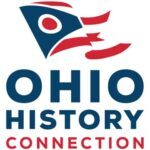Looking for resources to help you identify artifacts or objects? Check out our LibGuide!
Ohio History Connection's Archaeology Collection consists of more than 5,800 separate collections containing more than one million objects and representing 15,000 years of Ohio's cultural heritage. Striking examples include the Adena Pipe, copper and obsidian artifacts from the Hopewell Mound Group, the Tremper effigy pipes and Adena engraved tablets. Our collections also provide the basis for current and future archaeological research projects, exhibits and educational programs. As of January 2022, the Ohio History Connection has over 87,000 Archaeology collection and object records available to view on our Online Collections Catalog.
The first site in the Ohio History Connection's site system was the Fort Ancient Earthworks, which was acquired in 1891. The Fort Ancient Earthworks, a National Historic Landmark, are a series of earthen embankments that extend for more than 3½ miles around a high bluff along the Little Miami River in southwestern Ohio. Other archaeological sites in our network include the Newark Earthworks a National Historic Landmark and Ohio's state prehistoric monument, and Serpent Mound, a National Historic Landmark.
The objects in our Archaeology Collection tell the story of Ohio's past, from American Indian mounds to historic battlefields.
ExploreThis digital library has more than 27,000 images from Ohio History Connection and 330 other historical societies, libraries and museums.
Visit Ohio MemoryOhioPix is an image reproduction database managed by Ohio History Connection, including hundreds of images of archaeology collections.
Visit Ohio Pix
Ohio History Connection accepts archaeological collections with educational and/or research potential and that fulfill collecting guidelines. Check out Donation FAQ for more information or Contact Us if you are interested in donating material.
Ohio History Connection also curates collections resulting from Cultural Resource Management (CRM) projects required by Federal and/or state laws, a service for which Ohio History Connection will normally assess a fee. Contact the Archaeology Department to request current curation forms and processes.
We are currently accepting archaeological collection and site research applications. Please visit our Research Requests & Inquires landing page for more information.


Ohio History Connection staff work with Ohio’s strong and committed archaeological community to increase awareness, train educators, preserve, and interpret Ohio’s rich ancient past at Ohio History Center, at our historic sites around the state, and through publications and educational programs.


Linda started at Ohio History Connection after receiving her BA in Anthropology from Ohio State University. As Curator, she is responsible for the creation and upkeep of department databases and records creation and upkeep, cataloging and other collection care and research duties. In the course of her work, she has had the opportunity to conduct investigations at several Ohio History Connection holdings, including Pickawillany; Fort Ancient; U.S. Grant Boyhood Home, Schoolhouse, and Birthplace; John Rankin House; Miamisburg Mound; Fort Meigs; Flint Ridge Ancient Quarries & Nature Preserve; Newark Earthworks; Leo Petroglyphs and Nature Preserve; William Henry Harrison Tomb; Quaker Yearly Meeting House; Zoar Villiage; Paul Laurence Dunbar House; and the Ohio River Museum. Linda is an avid scuba diver and has managed to mesh her passion for archaeology with diving right here in Ohio. She is a founding member of the Maritime Archaeological Survey Team (MAST), a 501(c)(3) non-profit dedicated to the documentation of Ohio's underwater cultural resources, otherwise known as shipwrecks. Efforts of MAST have resulted in the instruction of hundreds of scuba divers from Ohio, surrounding states and Canada on underwater survey techniques; Ohio, national and international shipwreck law, research and report writing. The outcomes have been the listing of shipwrecks as Ohio archaeological sites with the State Historic Preservation Office, project reports, and Ohio's first underwater dive slates (maps) of shipwrecks. In addition to MAST, Linda's other memberships include the American Anthropological Association, Association for Great Lakes History, Midwest Archaeological Conference, National Speleological Society, Ohio Archaeological Council, Ohio Council of Skin and Scuba Divers, Save Ontario Shipwrecks, Society of American Anthropologists, Society for Historical Archaeology and several Ohio dive clubs. She was born and raised in Marion County, just north of Waldo, Ohio. She presently resides in Delaware with her husband Scott, Dee Dee the dog, and Zoë the cat.


Sara has a bachelor’s degree in anthropology from the University of Cincinnati and a master’s degree in applied anthropology from Indiana University Indianapolis. Her previous research has focused on ceramic analysis and settlement patterns of the Fort Ancient material culture in the Ohio River Valley. She has worked at a variety of archaeological sites including precontact and historic occupations near places now known as Cincinnati OH, Indianapolis IN, and Montañita, Ecuador. Prior to joining the Ohio History Connection in 2024, she pursued broad opportunities to establish skillsets in archaeological field techniques, object care, and collaborative methodologies. She applies these skills to care and advocate for the archaeological collections at the Ohio History Connection.
Originally from the Indianapolis area, Sara has spent her life in the Midwest and has developed a distinct passion for local histories and landscapes of memory. In her free time, she enjoys hiking, reading, collecting houseplants, and exploring parks with her dog, Talos, and her cat, Gremlin.


We appreciate the hard work of the interns and volunteers who have spent hundreds of hours of their time working on projects both in the lab and out in the field. For more information on volunteer opportunities, visit the Volunteer page.
